Considerations for designing a set play offense
There are several things you should consider when designing a set play offense for your team.
As you will soon notice, some of the points in the checklist below are contradictory. For example, the plays should have options, and they should be easy to remember. Yet the more options you have, the more difficult the plays will be to remember.
How should you resolve these contradictions?Pick a few points of emphasis to suit your current team. For example, if you need to improve your offensive rebounding, start by making sure your plays provide good opportunities for offensive rebounding.
Here are 19 things you should consider when designing a set play offense.
1. Will the plays work in the long run?
Technology has made scouting easy, so your offense isn’t going to surprise anyone. The plays need to give you quality shots, even though the other team knows them.
2. Do the plays fit your team?
What qualifies as a quality shot depends on your players. Make sure your plays get you shots your athletes can make.
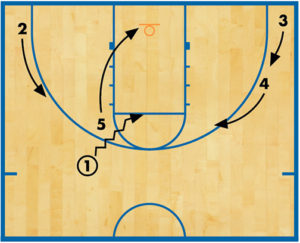 DIAGRAM 1: Pick & roll. While running a pick and roll, you want to spot up your shooters behind the 3-point line only if you have capable perimeter players on the floor. 1 drives off a screen from 5, and 5 then rolls to the basket. 2, 3 and 4 rotate and prepare for a potential kick out from 1.
DIAGRAM 1: Pick & roll. While running a pick and roll, you want to spot up your shooters behind the 3-point line only if you have capable perimeter players on the floor. 1 drives off a screen from 5, and 5 then rolls to the basket. 2, 3 and 4 rotate and prepare for a potential kick out from 1.
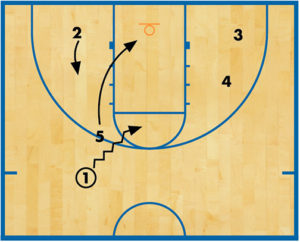 DIAGRAM 2: Inside shot. If your team does not have capable 3-point shooters on the floor, the spacing of the pick-and-roll must be changed. 2, 3 and 4 position themselves for an inside shot.
DIAGRAM 2: Inside shot. If your team does not have capable 3-point shooters on the floor, the spacing of the pick-and-roll must be changed. 2, 3 and 4 position themselves for an inside shot.
3. How well do you know the plays?
It makes sense that a team should run the same plays season in and season out, since it takes time for both the coaches and the players to fully grasp the nuances of a certain play.
4. Do the other teams know your plays?
Running the same plays year in and year out has a downside: The opponents will be familiar with those plays. The same thing happens if a lot of teams in your league run similar plays.
5. How long will it take to start the set offense?
You shouldn’t need to reset after your fast break or secondary break. Your players should end up in the proper formation to start the set play right away.
 DIAGRAM 3: Formation reset. If a 2-3 is where your players end up after a break, then this should be the formation where you start most of your set plays as well.
DIAGRAM 3: Formation reset. If a 2-3 is where your players end up after a break, then this should be the formation where you start most of your set plays as well.
6. Do the plays include swinging the ball?
Most of the time, it’s a good idea to swing the ball from side to side before transitioning into serious scoring action. Swinging the ball forces the defense to move, thus providing the offense opportunities to drive and go backdoor.
7. Will the plays get you to the free-throw line?
Never mind the level of play; a free throw is a good shot. While designing your set plays, consider which actions allow your players to draw fouls. The plays should create opportunities to get the ball inside, get offensive rebounds and drive to the basket.
8. Does the player with the ball have space?
Ideally, anytime someone catches the ball, he or she should have an opportunity to pass, shoot or drive. Often the critical point is having enough space so they can do so.
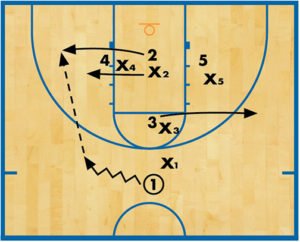 DIAGRAM 4: Diamond set. Often when you run the diamond set, the defender on 2 will go above the screen set by 4.
DIAGRAM 4: Diamond set. Often when you run the diamond set, the defender on 2 will go above the screen set by 4.
 DIAGRAM 5: Stationary. If the other offensive players stay where they are, it makes it difficult for 2 to drive or complete a pass.
DIAGRAM 5: Stationary. If the other offensive players stay where they are, it makes it difficult for 2 to drive or complete a pass.
 DIAGRAM 6: Movement. Pre-planned movement creates driving and passing options for the ball handler.
DIAGRAM 6: Movement. Pre-planned movement creates driving and passing options for the ball handler.
9. Will you get offensive rebounds?
Your plays must fit your offensive rebounding scheme. For example, if you only send your forwards to the glass, your plays had better put them in a good rebounding position.
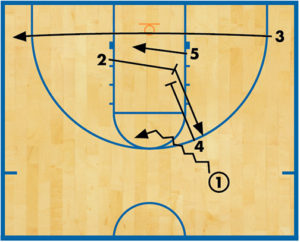 DIAGRAM 7: Rebounding. This familiar screen-the-screener action puts 4 and 5 in excellence offensive rebounding positions.
DIAGRAM 7: Rebounding. This familiar screen-the-screener action puts 4 and 5 in excellence offensive rebounding positions.
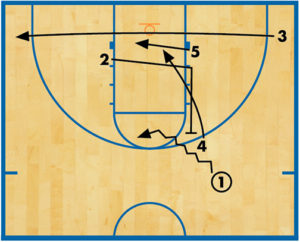 DIAGRAM 8: Alternative option. The modification where 4 gets a backscreen from 2 makes it even more difficult to block out 4.
DIAGRAM 8: Alternative option. The modification where 4 gets a backscreen from 2 makes it even more difficult to block out 4.
10. Do the plays have options?
Remember, your opponents will learn your plays. But if you have two or three options, it’s hard to stop them all. It is especially important to have different entries into the play.
 DIAGRAM 9: Pass. Some teams start their diamond set with 1-to-2-to-1 passes.
DIAGRAM 9: Pass. Some teams start their diamond set with 1-to-2-to-1 passes.
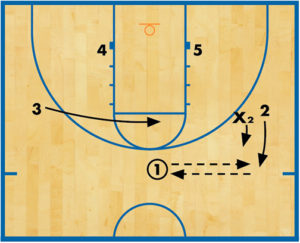 DIAGRAM 10: Defensive adjustment. The defense may counter by overplaying 2 to disrupt the spacing and time.
DIAGRAM 10: Defensive adjustment. The defense may counter by overplaying 2 to disrupt the spacing and time.
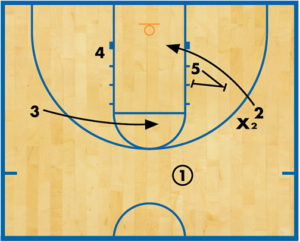 DIAGRAM 11: Counter. The offense should have an option. If 2 is overplayed, 4 steps up to set a backscreen.
DIAGRAM 11: Counter. The offense should have an option. If 2 is overplayed, 4 steps up to set a backscreen.
11. Do the options produce makable shots?
Imagine you run a play to the get the ball inside to your center. If the defense denies the first option, you go to the second one, and ideally that too should get the ball inside to your center. At the very least, the other options should lead to makable shots, considering your personnel.
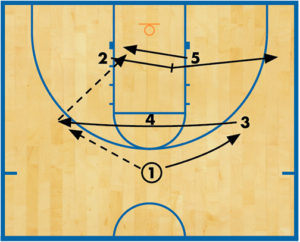 DIAGRAM 12: Score inside. This is a common play to post up your center, 5, and get a good look inside.
DIAGRAM 12: Score inside. This is a common play to post up your center, 5, and get a good look inside.
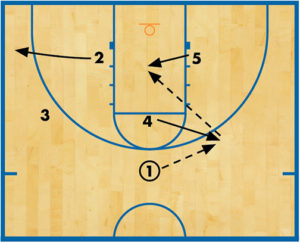 DIAGRAM 13: Adjust. If the defense denies the pass to 5, 4 pops out and receives the ball from 1.
DIAGRAM 13: Adjust. If the defense denies the pass to 5, 4 pops out and receives the ball from 1.
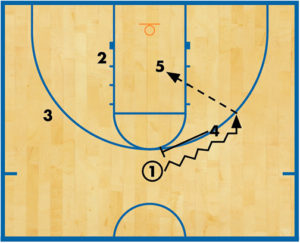 DIAGRAM 14: Final option. If the defense somehow manages to deny both passes, 4 sets a pick for 1, who drives to the wing and again look to find 5 in the post.
DIAGRAM 14: Final option. If the defense somehow manages to deny both passes, 4 sets a pick for 1, who drives to the wing and again look to find 5 in the post.
12. Do the plays serve multiple purposes?
Can you run the same plays (with minor adjustments) against man-to-man, special defenses and different types of zones? Can you use your set plays as out-of-bounds plays as well? If you can, you save a lot of practice time.
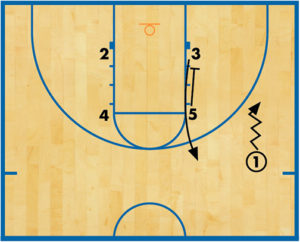 DIAGRAM 15: Zipper. There are plenty of variations of the zipper play. 3 pops to the perimeter, using a downscreen from 5.
DIAGRAM 15: Zipper. There are plenty of variations of the zipper play. 3 pops to the perimeter, using a downscreen from 5.
 DIAGRAM 16: Out of bounds. The zipper play also works as a side out-of-bounds play.
DIAGRAM 16: Out of bounds. The zipper play also works as a side out-of-bounds play.
13. Are the plays simple enough?
The real difficulty of executing a play lies in reacting to the defense. Plays must be as simple and easy to remember as possible. The easier the plays, the fewer opportunities the opponents have to break them down.
14. How difficult are the plays to scout?
The easier for you to remember, the easier for them to scout. To make scouting more difficult, run all the plays from the same formation, use misdirections, keep your signals as secretive as possible and continually modify your plays.
15. How easy are the plays to modify?
Modifying plays makes scouting difficult and helps you adjust your own game. There are plenty of ways to modify plays. Change the direction of the screen (like downscreens to backscreens). Use a handoff instead of a pick and roll. Switch the starting positions of the players. Use different formations. Diagrams 17 and 18 show how you can use two different formations to achieve the same result.
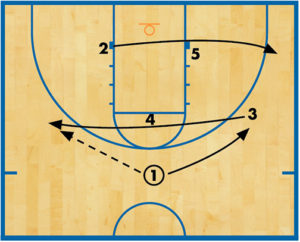 DIAGRAM 17: Isolation. If you want to isolate 3 on the left wing, you can use these two sets. The first is a 1-2-2, where 3 crosses to the opposite wing and 2 finds the corner.
DIAGRAM 17: Isolation. If you want to isolate 3 on the left wing, you can use these two sets. The first is a 1-2-2, where 3 crosses to the opposite wing and 2 finds the corner.
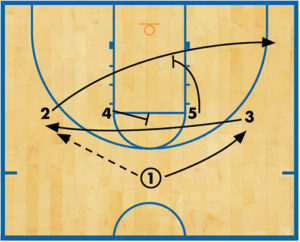 DIAGRAM 18: Option two. This play also brings 3 across to the opposite wing from a 1-4 high set. 2 finds the same position in the opposite corner.
DIAGRAM 18: Option two. This play also brings 3 across to the opposite wing from a 1-4 high set. 2 finds the same position in the opposite corner.
16. What can be done about turnovers?
Admit that you will commit turnovers, and then scrutinize your plays. Where will the turnovers most likely occur? What can be done to avoid them? How can you minimize the damage caused by turnovers?
17. Can you teach the required skills?
In one of your set plays, your center may pop-out and swing the ball. Or your guard may give a handoff pass off the dribble. If they don’t yet know how to execute those skills, do you know how to teach them?
 DIAGRAM 19: Right hand. To swing the ball from side to side, 5 must execute a rush pass.
DIAGRAM 19: Right hand. To swing the ball from side to side, 5 must execute a rush pass.
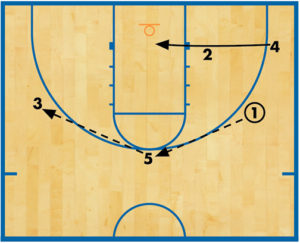 DIAGRAM 20: Left hand. There is a significant difference between the motion made with the right hand in Diagram 19 and the left hand shown here.
DIAGRAM 20: Left hand. There is a significant difference between the motion made with the right hand in Diagram 19 and the left hand shown here.
18. Must the opponents alter their defense?
A lot of teams have, at best, one effective way of defending a particular action. You want to build an offense where the same action can’t be defended the same way every time. Pick-and-roll is the most obvious action to use.
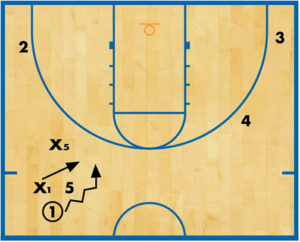 DIAGRAM 21: Pick. When a pick is set far from the basket, a lot of teams have the on-the-ball defender go under the pick.
DIAGRAM 21: Pick. When a pick is set far from the basket, a lot of teams have the on-the-ball defender go under the pick.
 DIAGRAM 22: Adjust. When you continue the play with a re-pick, the defense needs to do something else, or it will have a hard time covering you.
DIAGRAM 22: Adjust. When you continue the play with a re-pick, the defense needs to do something else, or it will have a hard time covering you.
19. Do the plays fit your long-term plan?
If you are building a program based on fast break offense, you are going to run nothing but plays that fit that scheme.









